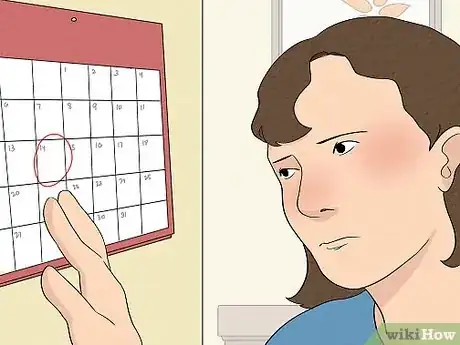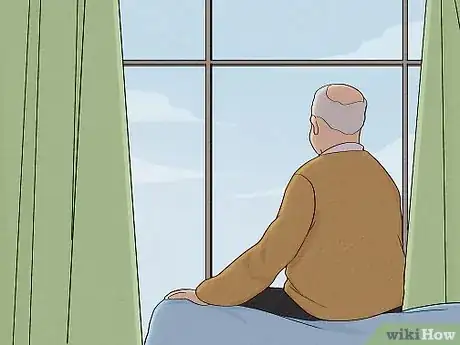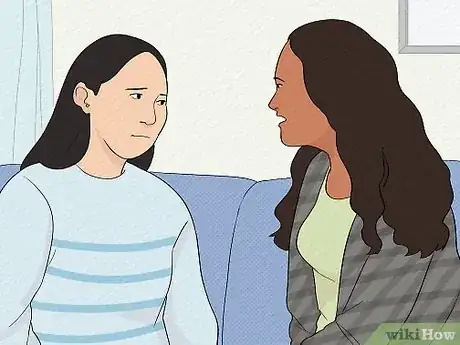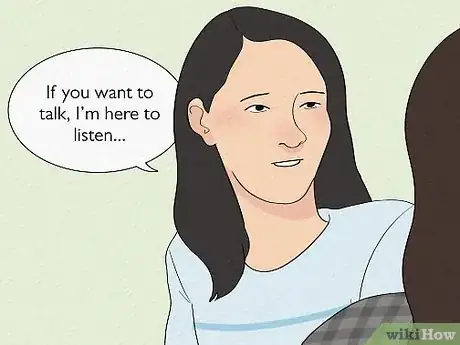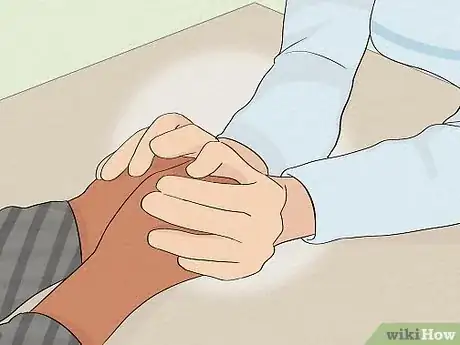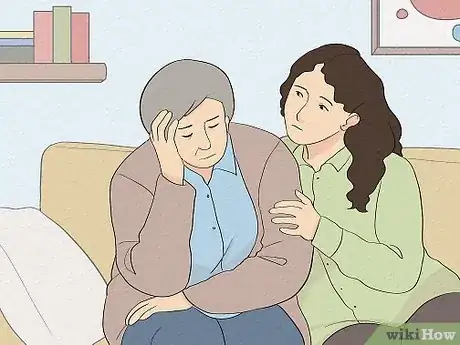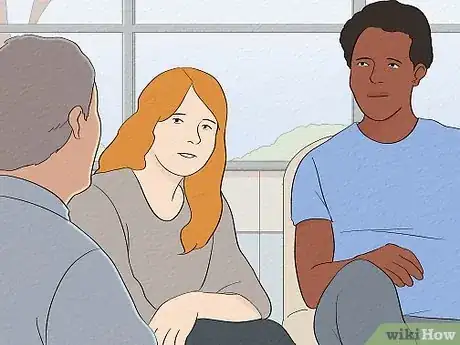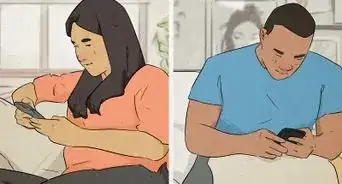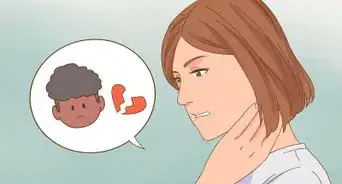This article was written by George Sachs, PsyD and by wikiHow staff writer, Dev Murphy. George Sachs is a Licensed Psychologist and the Owner of Sachs Center based in New York, New York. With over ten years of experience, Dr. Sachs specializes in treating ADD/ADHD and Autism Spectrum Disorders in children, teens, and adults. He holds a BS in Psychology from Emory University. Dr. Sachs earned his Doctorate of Psychology (PsyD) from the Illinois School of Professional Psychology, Chicago. He completed his clinical training in Chicago at Cook County Hospital, Mt. Sinai Hospital, and the Child Study Center. Dr. Sachs completed his internship and postdoctoral work at the Children’s Institute in Los Angeles, where he supervised and trained therapists in Trauma-Focused Cognitive Behavioral Therapy (TFCBT). He has been trained as a Gestalt Therapist and certified by the Gestalt Associates Training Program of Los Angeles. Dr. Sachs is the author of The Adult ADD Solution, Helping the Traumatized Child, and Helping Your Husband with Adult ADD. He has appeared on the Huffington Post, NBC Nightly News, CBS, and WPIX discussing his holistic approach to ADD/ADHD treatment.
There are 9 references cited in this article, which can be found at the bottom of the page.
When PTSD causes someone you love and care deeply about to shut you out, it can be hard to know how to respond. Should you give them space? Let them go? Keep pushing them? Post-Traumatic Stress Disorder is a serious condition to live with, both for sufferers of PTSD and their loved ones, but by keeping patient, educating yourself on the symptoms of PTSD, and tuning into your loved one’s needs, it’s possible to maintain a healthy relationship where both you and your loved one feel supported.
This article is based on an interview with our licensed psychologist, George Sachs, owner of Sachs Center. Check out the full interview here.
Things You Should Know
- Understand that isolation is a common symptom of PTSD. Try not to take it personally, and give your loved one time and space if they need it.
- Let them know you're there for them if they want to talk, and try to maintain a calm and relaxing environment.
- Discuss their triggers with them so that you can both develop a game plan for handling triggers when they arise.
- Take care of yourself, and don't put your life on hold for your loved one. Their well-being is important, but it doesn't take precedence over yours.
Steps
What You Can Do
-
1Remind yourself that their trauma isn’t about you. Your loved one is struggling with powerful anxiety and fear, and though you will almost certainly feel the effects, they likely can’t control it. Try not to feel hurt when they suddenly withdraw from you: it’s not anything you’ve done, and it’s not a reflection of how they feel about you.[7]
- Your loved one is stuck in a state of constant vulnerability and high alert which might make them irritable, depressed, anxious, and mistrustful.
- Don’t take it personally—but also don’t feel pressure to “fix” them or their symptoms. You can support them without taking on responsibility for their emotions or actions.
-
2Voice your support without pushing them. When your loved one isolates, they may just need some time alone, or they may need a shoulder to lean on. Voice your presence and support, but don’t push them to come out of their shell sooner than they’re ready to. They may not know what they need in the moment, but it’s important that you give them the agency to decide.[8]
- You can show support in a variety of ways. You can make them tea or dinner, or just communicate that you’re there and that there’s no rush for them to feel better.
- Sometimes, all a person needs is to know that they won’t be forgotten or abandoned while they work through their difficult emotions. Knowing you’ll be there when they emerge may even make them feel better sooner.
-
3Offer a listening ear. Your loved one may not want to talk about their experiences—or they may want to talk a lot! Let them know you’re there to listen, but don’t pressure them to open up to you about their trauma if they don’t want to. Even if they don’t end up wanting to talk, they may feel calmer knowing you’re there and that you care.[9]
-
What to Do:
- Let them take the lead, and practice active listening: nod, maintain eye contact, and respond and ask questions that indicate engagement and offer validation: “That must have been really hard,” “When did that happen?” “I’m glad you’re telling me all this.”
- Keep the focus on them and on how they feel, rather than what you feel about their experience. You’ll probably feel a lot of things—but this conversation isn’t about you.
-
What Not to Do:
- Avoid empty platitudes that may come across as dismissive, like “Everything will be OK,” “There’s a reason for everything,” or that they’re “lucky” things weren’t worse.
- Some of what they say may be very hard to listen to, especially if they suffered or inflicted violence. Try to avoid showing judgment or horror, as this may discourage them from opening up to you again.
-
What to Do:
-
4Use nonjudgmental language. When you show support of your loved one or talk to them about their trauma, use respectful, gentle, and nonjudgmental language. Try to avoid giving unsolicited advice or telling them what they “should” do. Let them know you’re there for them, you see that they’re suffering, and you want them to know they’re not alone. Keep in mind that you aren’t in control of what they need, and what they want to do may not align with what you want them to do.[10]
- “If you want to talk, I’m here to listen, but I understand if you don’t feel comfortable opening up to me. I’ll check in with you later, but there’s no pressure to talk if you don’t want to.”
- “I can tell you’re suffering a lot right now. Would you like me to stay with you? I’m here if you want to talk, but I’m also happy to sit quietly with you if that’s what you need.”
- “You’ve struggled a lot. I love you so much, and I’m so glad you’re here. Let me know if I can do anything to support you.”
- “I know you want to be alone when you're upset. And that’s OK. I love you, and I’ll do what I can to support you through the hard moments. Take as much time and space as you need.”
-
5Work to rebuild trust and safety. Your loved one is struggling to feel safe and secure, and while you can’t erase their trauma, you can help them to feel more comfortable and rebuild their trust. Let them know you’re committed to your relationship and to supporting them through the difficult times.[11]
- Establish routines with your loved one, like regular walks or nightly tea and conversation, or cooking dinner together. Structure can help restore a feeling of stability and safety.
- Talk about the future with them. Make plans, and keep your promises.
- Minimize stress around them. If you live together, try to keep your home life calm and relaxing.
- Encourage and empower them by acknowledging their strengths and reminding them of all their successes. This will help to reestablish their self-trust and self-confidence.
-
6Stay alert to likely triggers. PTSD can be triggered by reminders of the traumatic event. For instance, if your loved one was in combat, seeing their veteran friends may be hard for them, or being in crowds may make them feel on high alert. Triggers may be internal (happening inside the body) or external (happening outside the body). Being aware of what might trigger your loved one can help you and them to manage their reactions.[12]
- Some triggers may be avoided, but many just need to be managed and planned for. Ask your loved one what has helped them deal with a trigger in the past, and develop a game plan with them to respond to triggers when they arise in the future.
-
7Keep doing “normal” things with them. One of the hardest parts of experiencing trauma is returning to “normal” life. Doing everyday activities with your loved one and talking about everyday things will help ground them and make them feel connected to “normal” life again. It may also offer a welcome distraction from their symptoms.[13]
- Your loved one struggles with PTSD, but PTSD doesn’t define them. Invite them to parties or to dinner, ask them to watch a new TV show with you, talk about “normal” things, like the weather or your day. This will not only help ground them in reality or distract them from their symptoms; it may reassure them you don’t view them as “different.”
-
8Be patient. Watching your loved one suffer is hard. Feeling they’re withdrawing from you is hard too. But try to be patient and remain calm. Give them the space and time to heal in what way works best for them. Voice your support, but in the meantime, keep doing your thing.[14]
- When your loved one is struggling, you might feel pressure to help, or their anxiety may make you anxious or irritable yourself. Try to remain calm and take their PTSD symptoms in stride.
- You may feel helpless, or as if just sitting and waiting isn’t doing any good. But your loved one may be encouraged to know there’s no pressure for them to heal faster.
-
9Practice good self-care. Supporting someone struggling with PTSD can drain you if you don’t take good care of yourself and *establish appropriate boundaries. Remember that you’re not responsible for your loved one’s recovery, and that in order to offer them the best support, you need to take frequent breaks and bring in outside help as needed, and don’t put your life on hold for them.[15]
- Get good self care by getting plenty of exercise, eating well, and taking time to pursue your own interests. This will help you maintain independence and avoid slipping into a codependent relationship with your loved one.
- Supporting someone with PTSD can in turn affect your own mental health. If you feel drained, or even traumatized yourself by what your loved one has been through, try confiding in a therapist or a trusted friend or family member. Remember, your loved one’s well-being doesn’t take precedence over your own.
- Taking care of yourself may mean encouraging them to get additional support elsewhere. You can do a lot to support your loved one in their time of need, but they may also benefit from outside help, such as medication, therapy, or a support group.
References
- ↑ https://www.mayoclinic.org/diseases-conditions/post-traumatic-stress-disorder/symptoms-causes/syc-20355967
- ↑ https://www.nimh.nih.gov/health/publications/post-traumatic-stress-disorder-ptsd
- ↑ https://www.psychologytoday.com/us/blog/trauma-and-hope/201703/different-types-trauma-small-t-versus-large-t
- ↑ https://www.ptsd.va.gov/publications/print/understandingptsd_family_booklet.pdf
- ↑ https://fherehab.com/learning/reasons-ptsd-self-isolating/
- ↑ https://fherehab.com/learning/reasons-ptsd-self-isolating/
- ↑ https://www.ptsd.va.gov/publications/print/understandingptsd_family_booklet.pdf
- ↑ https://www.psychologytoday.com/us/blog/invisible-bruises/202203/5-ways-be-there-loved-one-trauma-history
- ↑ https://www.psychologytoday.com/us/blog/invisible-bruises/202203/5-ways-be-there-loved-one-trauma-history
- ↑ https://www.psychologytoday.com/us/blog/invisible-bruises/202203/5-ways-be-there-loved-one-trauma-history
- ↑ https://www.psychologytoday.com/us/blog/understanding-ptsd/202008/understanding-intimacy-avoidance-in-ptsd
- ↑ https://www.psychologytoday.com/us/blog/the-addiction-connection/202107/how-ptsd-can-affect-your-relationship
- ↑ https://www.ptsd.va.gov/publications/print/understandingptsd_family_booklet.pdf
- ↑ https://www.psychologytoday.com/us/blog/invisible-bruises/202203/5-ways-be-there-loved-one-trauma-history
- ↑ https://www.psychologytoday.com/us/blog/invisible-bruises/202203/5-ways-be-there-loved-one-trauma-history
- ↑ https://www.ptsd.va.gov/understand/what/aging_veterans.asp


